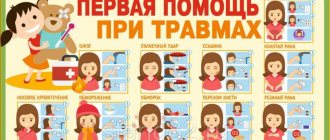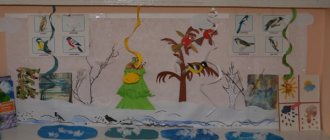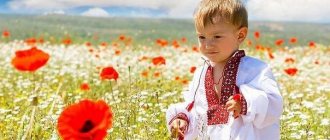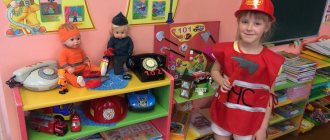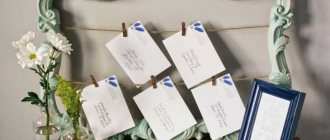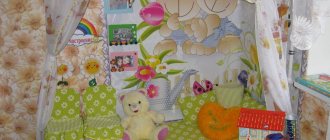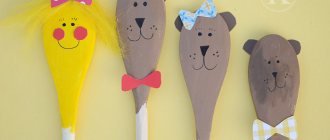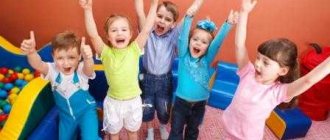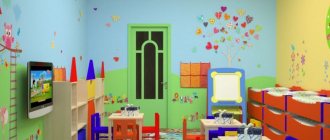DIY design according to Federal State Educational Standards + photo
The safety of children is the most important task for parents, educators and all adults who surround them. Unfortunately, there are a lot of dangers in the world around us that can cause harm. Therefore, it is necessary not only to intensively protect and protect the child, but also to teach him safe behavior in various situations both in the house and outside it. This work is purposefully carried out in all educational institutions, starting from a young age in kindergarten and gives positive results. Because despite the complexity of the organization of modern society, childhood injuries are an emergency situation for which all those responsible bear responsibility.
Safety training in kindergarten
Teaching children not to get into dangerous situations both at home and in the outside world is the most important task for parents and educators in child care institutions. It is necessary to teach children safe behavior from the very first steps of life. There are a large number of situations when a child can get injured at home, on a walk, while playing, or while traveling in public transport. The main task of adults is not only to ensure control over the behavior of children, but also to instill in them the concept of their own safety . a safe behavior corner in kindergarten is intended to solve this problem. Using stands, models, toys, and didactic games, educators teach preschoolers the rules of behavior in the most likely life situations. The materials presented at the stands are also addressed to parents, since the child is with them most of the time, and young parents cannot always properly create a safe environment at home.
Table: studying the rules of life safety in different age groups of kindergarten
Design of a safety corner
The importance of the safety corner in the educational activities of teachers is quite great. But in order to successfully and efficiently teach children the basics of safety, it is necessary to have interesting and varied material in this area of work. The life safety corner may contain:
- Stands with information for parents about possible traumatic situations.
- Analytical reports on emergency incidents involving children.
- Visual materials for teaching safe behavior for children and adults.
- Didactic games (“Road Signs”, “Good and Evil Fire”, “Smart Traffic Light”, “Safety Fundamentals” and so on) factory-made and hand-made.
- Models of fire equipment, ambulance, fire shield - to better familiarize children with emergency services.
- Models of items for personal safety: reflectors, fire detector, fire extinguisher, emergency telephone numbers.
- Toys for organizing role-playing games: firefighter dolls, rescuers, policemen; children's equipment for traffic police and rescue service workers.
- Floor covering for designing traffic when studying traffic rules.
As part of the subject-development environment of the kindergarten, the safety corner must meet the requirements: aesthetic and attractive design for children and parents, functionality and variability, periodic updating of the content to maintain interest in the material.
Corner for ensuring life safety in preschool educational institutions
The task for us, teachers and parents, is not only to protect and protect the child, but also to prepare him to face various difficult and sometimes dangerous life situations. Here is such a corner to ensure the safety of preschool children, made in our group.
It's no secret that the current social and environmental situation is causing concern among people all over the planet.
We feel special concern for the most defenseless citizens – small children. While the child is small, adults are more or less calm: they will help the child, insure, warn, not allow... But soon, very soon there will come a time in the life of the family when the child will need to start letting go of him. Is the child ready to take independent steps? Will he be able to protect himself and avoid danger? We need to think about and take care of this now, while the child is next to us, adults. The task of us teachers and parents is not only to protect and protect the child, but also to prepare him to face various difficult and sometimes dangerous life situations. Work experience shows that only those who obtain the necessary knowledge about existing dangers, learn to recognize them in a timely manner, avoid them, contain them and reduce them can help themselves in a difficult situation. They said correctly in the old days: beware of troubles while they are not there. Preschool age is the most important period when personality is formed and solid foundations of life experience and a healthy lifestyle are laid. Due to its physiological characteristics, a baby cannot independently determine the full extent of the danger. Therefore, an adult is entrusted with the mission of protecting his child. P. Leach and P. Statman note in their research that the advantage of preschoolers in learning personal safety is that they love rules and completely adhere to them. If the rules are forgotten or deviated by someone, then the baby instantly reacts to this. A child of this age’s desire for logic will help adults teach him safety rules. K. D. Ushinsky wrote that “education reduces the number of dangers that threaten our lives, reduces the number of causes of fear and, by making it possible to measure the danger and determine its consequences, reduces the intensity of fear due to these dangers.” This work should be included in all sections and areas of the education program in kindergarten: • organized forms of teaching in the classroom, • joint activities of an adult and a child, • independent activity of a child, • education of behavior skills, • familiarization with the environment, • speech development, • artistic literature, • construction, • fine arts, • games. That is why our preschool educational institution pays great attention to the issues of children's health, safety and safety. The goal of my project: to develop in children the conscious implementation of rules of behavior that ensure the safety of their lives and health in modern conditions of the street, transport, nature, and everyday life. Project objectives: • To form and expand understanding of the causes and consequences of careless handling of fire; • Familiarize children with traffic rules and safe behavior on the street; Explain the rules of communication with animals. • Teach children to behave correctly in dangerous situations such as contacts with strangers;
• Enrich children's understanding of health. To form in children basic ideas about the human body; • Teach how to care for your body, personal hygiene skills and basic care; Project implementation stages:
First stage: Preparatory. Goal: to determine the main directions of work. Objectives : to develop conceptual approaches to issues that form the life skills of a child in kindergarten. Second stage: Organizational. Goal: to draw up a program for a project of interaction between families, kindergartens and services that ensure the safety of human life. Objectives: assess the capabilities of prevention subjects; prepare the material and technical base. Create the necessary conditions for the prevention of basic life safety for children. Third stage . Basic. Goal: to carry out project activities to prevent the basics of safety. Objectives: selection of innovative methods of work to organize the prevention of the basics of children's life safety. Fourth stage. Analytical. Goal: systematize methodological material and compare intermediate results with project objectives. Objectives: quantitative and qualitative processing of intermediate results of the work. Fifth stage . Final. Goal: generalization of the experience gained; understanding it in the form of a model of psychological and pedagogical interaction between family, kindergarten and city services that ensure the safety of human life. The implementation of each specific topic goes through three stages: • Initial: examination of drawings, photographs, use of didactic games, familiarization with literary works that reflect various modes of behavior and, accordingly, precautions; • Main: thematic classes, thematic days, meetings and conversations, organization of excursions, leisure activities, games. • Final: KVN, productive activities, participation in regional competitions. As part of the project, we propose to pay more attention to the game when building the pedagogical process. Training, testing and consolidation of knowledge on the rules of safe behavior are effectively carried out in a playful way. For these purposes, various types of games can be used, both intellectual (board, didactic, and role-playing games (outdoor games, indoor, outdoor). The content of the project corresponds to the intellectual capabilities of older preschoolers. Based on the psychological characteristics of children, much attention is paid to clarity, based on the feelings and sensations of children. The products of this activity are: • creation of a baby book “The ABC of Safety”, • exhibitions of children's drawings, • photographs of activities, • layout “Our Street”, • notes of classes and themed days, • collection “Piggy Bank” riddles", • multimedia presentation. The implementation of the project "Formation of the fundamentals of life safety for children in preschool educational institutions" will help: • Develop children's skills for safe behavior on the street, in nature and at home; • Develop an algorithm for actions in emergency situations; • Form simple ideas about events aimed at maintaining health. To solve the problems of the project, conditions are necessary. One of them is the environment. The carefully thought-out developmental environment of the preschool educational institution itself encourages children to explore, be active, show initiative and creativity. The construction of a subject-based developmental environment by adults makes it possible to organize both joint and independent activities of children in such a way as to develop safe behavior skills in the child. In this case, the environment performs educational, developmental, nurturing, stimulating, organizational, and communicative functions. But most importantly, it works to develop the child’s independence and initiative. The life safety room in the preschool educational institution is equipped with technical means, such as a TV and a music center. Children have the opportunity to watch educational films: “Lessons from Aunt Owl”, fairy tales: “Peter in the Land of Traffic Lights”, etc., which help children reinforce the rules of life safety; Life safety corners in groups are equipped with: • didactic games; • educational layouts, intersections; • books by different authors on relevant topics; • reference literature: encyclopedias, reference books; • building designer with medium and small sized blocks; • transport: special transport (ambulance, fire truck, police car); • printed board games; • a model of our neighborhood with markings, road signs, transport, traffic lights, small toys-dolls; • various albums on this topic, children's drawings; • audio cassettes, video cassettes, works of art according to traffic rules; • albums with poems and riddles, coloring books; • illustrations about dangerous situations in the lives of children; • family projects: “Road Signs”; “Rules for using a bicycle”, “Traffic rules that we follow with our family”, etc. Thus , the achievements of students in the formation of rules of safe behavior are objectively high, which allows us to evaluate the fairly high result of the existing system of work in the educational process. To preserve the health of children, reduce morbidity and promote a healthy lifestyle, all the necessary conditions have been created in the kindergarten. These are: - flexible daily routine; — hardening activities; — good nutrition, vitaminization; - medical office; — compliance with SanPiNov; — relaxation room; — sports ground; — gym; — motor mode; — music hall; -thematic classes. The medical staff in our preschool educational institution conducts medical examinations, immunizations, examinations of children, and massages. The teacher teaches the children self-massage and play massage. Classes organized by a physical education instructor not only help improve the health and physical development of children, but also improve their overall vitality. In music classes with children, musical-rhythmic and breathing exercises and chants are used, which contribute to the development of the respiratory, speech, musculoskeletal, and cardiovascular systems of the children’s body. To promote a healthy lifestyle, thematic classes, interesting leisure activities, holidays, and health days are held with children in the garden. Close interaction with various specialists inside and outside the educational institution will allow you to successfully form initial concepts on the rules of safe behavior. Active involvement of parents in the process of learning and mastering by children the skills of a healthy lifestyle, safe behavior on the street and in everyday life takes place at parent-teacher meetings, open classes, seminars and consultations. Contact with parents helps not only to collect material, but also to attract parents to participate in events. The peculiarity of children receiving the basics of safe behavior largely depends on cooperation with parents, with whom complete mutual understanding has been achieved. Parents are our interested partners in the learning and development of children. When interacting with parents, I used various forms of work: individual dialogue; introduction to reading literature about the culture of behavior on the roads; familiarization with publications from the local press; inviting parents to a meeting on safety topics with the participation of traffic police officers; conducting open classes and entertainment with the participation of parents; awareness of parents about the positive dynamics of the formation of rules of safe behavior; participation in competitions; operational information about the state of child injuries from the traffic police for parents; • information stands, folders, reminders, where parents are given recommendations on how to behave with their child, taking into account the age of the children. Now that many parents have video equipment and computer equipment, they can be used to teach their child safety rules. The example of elders should help the child develop the habit of behaving in accordance with the basic rules of child safety. Throughout the year, in mobile folders, I place material about the rules that children must learn, a list of literature for adults and children. Thus, systematic work with children to teach the rules of life safety, the use of effective, modern methods and techniques, and taking into account age characteristics give positive results. Diagnostics of knowledge on traffic rules and safe behavior shows the following results: that all children know the rules for crossing the road with and without traffic lights, they know perfectly well the rules of behavior for passengers, the rules of behavior at home and with strangers. Predicted result of the project: Children:
- conscious attitude to issues of personal safety and the safety of others;
— manifestation of discipline, self-control, independence in observing the rules of behavior; - the ability to anticipate possible danger and find ways to avoid it; - knowledge of the rules of safe behavior on city streets. — the ability to take care of one’s physical health and comply with life safety rules; — the ability to choose an adequate model of behavior in various life situations; — the ability to organize activities in accordance with the rules of behavior that is safe for oneself and others in “typical” situations; — the ability to act in extreme situations in accordance with the learned rules on the road; - ideas about possible negative consequences for other people by their careless actions. Parents:
- conscious involvement in raising a safe type of personality.
Teachers: - formed orientation towards the implementation of a competency-based approach to the development of healthy and safe lifestyle values. The proposed project is an attempt to show in practice the system of activities of parents and educators of preschool educational institutions to teach preschoolers basic safety rules. To develop in children the necessary ideas, abilities and skills of safe behavior in various situations. We are convinced that targeted work on this project undoubtedly produces positive results. We believe that this area of work should always be under the close attention of teachers and parents, which means that further search and improvement is necessary in organizing work to prevent the basics of safety in children.
We recommend watching:
Safety of conducting classes on the playground and in the gym Notes of a lesson on fire safety in the preparatory group Notes of a lesson on life safety in the middle group Scenario of child-parent entertainment for the preparatory group. Safety regulations
Similar articles:
Summary of a lesson on life safety for kindergarten on the topic: In the world of dangerous objects
Summary of a lesson on cognitive development in the senior group. Poisonous mushrooms and berries
Lesson on basic safety in the senior group. Topic: Meeting a stranger
Summary of a lesson on life safety in the middle group. Visiting Doctor Aibolit
Summary of a lesson on life safety in the middle group on the topic “Preparation of vinaigrette (salad)”
Formation of the middle group.
Svetlana Yurieva
Formation of the middle group.
This summer we moved to a new group . After the previous one, where we lived for 2 years, this group seemed alien , not cozy, and after some thought, our parents decided to organize a cleanup day on their own, which, however, lasted 3 days. Without sparing their weekends, our parents came to our aid.
Assembling the kitchen set
Washed the group after painting
The team has arrived - just right!
Then it’s just a matter of making the group not only clean , bright and spacious, but also interesting for children. That's why I created development centers:
Fine, which was replenished with various means of depiction
Streets of our city according to traffic rules
Music and theater areas
Pochemuchek Corner - experimental zone
Center for Young Mathematicians
Children go to kindergarten with pleasure, everyone will find something to their liking.
Kindergarten decoration File “/upload/blogs/aa327c36105f8186cd0df59e99c44fa3. pg.jpg" not found. Subject-developmental environment of the group (middle preschool age). .
www.maam.ru
Traffic regulations pictures for the stand
Preschoolers, due to their age, do not yet understand the level of danger awaiting them on the road. In addition, kids are very active and inquisitive, which increases the risk of ending up on the road. It is precisely in order to teach children how to cross the road correctly, not to ride a bicycle and not to play in dangerous places near moving vehicles that illustrated stands are created in kindergartens. They help preschoolers consolidate the material they have learned about traffic rules in life safety classes.
Stand templates and ready-made posters in pictures of traffic rules for preschoolers
Road signs - pictures for the traffic rules stand
Pictures for designing sections of the traffic rules stand
The importance of a developing subject-spatial environment in the senior group of preschool educational institutions
The task of any preschool educational institution (DOU) is to create conditions for the development and upbringing of children, maintaining their health in a safe and comfortable environment. The most important component of this task is the organization of a subject-spatial environment that corresponds to the components of the educational and developmental process carried out by teachers. It has long been proven that a child’s development occurs with his active participation in a variety of activities. For senior group students, the following areas are highlighted:
- training and development activities;
- performing practical and creative work;
- role-playing games;
- basics of labor activity;
- physical education classes;
- music and choreography lessons.
The administration of a children's educational institution, teachers and educators must create a multi-component educational environment for a preschooler, which takes into account different aspects of organizing the process of raising and developing a child. This:
- developing subject-spatial environment;
- organizing interaction with teachers;
- communication with peers;
- the preschooler's attitude to the world around him and to himself.
Children should live in a world of beauty, games, fairy tales, music, drawing, fantasy, and creativity.
V. A. Sukhomlinsky
Principles of constructing a subject-development environment
The subject-spatial environment in the older group serves the development of children's activities, primarily play. Indeed, during play, the leading activity of preschool children, cognitive motivation develops, which is the basis of educational activity. The subject-spatial developmental environment must correspond to the zone of proximal mental development of a 5-6 year old child - the formation of prerequisites for educational activity.
Design of thematic areas in kindergarten
Showing publications 1-10 of 4579. All sections | Corners and centers in groups
Educational environment. Interesting corners in our group
Dear colleagues, I invite you to a mini excursion to our group. Our tour begins with a reception for children and parents. I tried to make it interesting for children and parents; when you go into the locker room you can see a stand “For moms and dads about the lives of their children.” Available at this stand.
Busyboard - educational class=”aligncenter” width=”399″ height=”675″[/img]
Good day, dear friends and guests of my page! Probably, many of you have heard about a development board for children, on which there are various fasteners, doors, buttons, etc. This development center is called a busy board. It was invented by Maria Montesori. Busyboard.
Sources
- Victor Mikhailovich Koryakin Arbitration process in schemes. Tutorial; Prospect - M., 2000. - 370 p.
- Smirnova 100 golden rules. Caring for indoor plants / Smirnova, Maria. - M.: Fiton+, 2008. - 160 p.
- Vox Juris collection. Voice of Law / Collection of articles. - M.: St. Petersburg State University, 2022. - 919 p.
- Alexander, Vasilievich Demin “Soft law” in an era of change: the experience of comparative research. Monograph / Alexander Vasilievich Demin. - M.: Prospekt, 2014. - 182 p.
- Law and Economics No. 08/2010; Justitsinform - M., 2010. - 839 p.
Menu for kindergarten templates pictures
Both parents and children study the menu in kindergarten with interest, because it is interesting to know what the pupils will be treated to today. Each group updates the form with the proposed menu daily, which is placed on the stand. It is especially pleasant to look at the menu, which is beautifully and stylishly designed. To do this, they set up a stationary stand on the wall, and then change the colorful insert templates on which the menu is written every day.
Stand templates with pictures for little ones
Ready-made menu forms for printing
